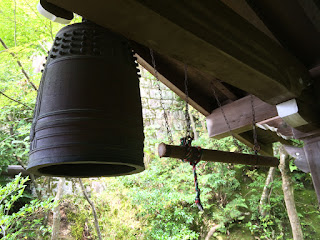I then had to decide where to put them. Most of the plants I purchased were shade tolerant. However, I also picked some sun plants with flowers as part of my plan to fill the area next to the bell and along the new fence with a small flower garden. Much of the Zen garden is too shady for bright flowing sun plants, so this may add a little color to the overall garden, especially since this fence/bell area gets a lot of sun.
I started out with a Ginko Craig Plantain Lily (Hosta x 'Ginko Craig'), as a Hosta, it actually likes shade so I will need to keep an eye on it. Just behind, I planted a Coreopsis 'Creme Brulee'. This variety has nice red flowers with a yellow center. I also planted two Dwarf Plumbago (Ceratostigma plumbaginoides) plants. These plants like part sun, but produce a nice purple flower in the fall.
Further back I planted an Iron Butterfly Narrow-Leaf Ironweed (Verononia lettermannii 'Iron Butterfly'). Full sun will produce nice flowers and attract butterflies. I also added a Sedum 'Autumn Fire' which should add some rich pink to bronze color to the area.
Just below the bell I planted a Moody Blues Mauve Speedwell. Its size is big enough to show some flowers but will not overwhelm the bell post.
Near the entry way to the garden from the backyard I decided to add a couple of ferns - Christmas Fern (Polystichum acrostichoides). They are very close to the bricks, but should do well in this location. Again, I will need to make sure they do not get too much light. More importantly, I may need to relocate if they spread to much.
I still have a long way to go to get through all the new plants.

























































